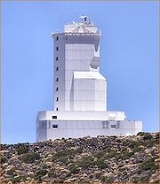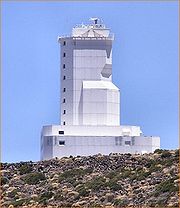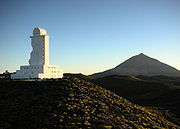
Vacuum Tower Telescope
Encyclopedia
For the vacuum tower telescope at Sacramento Peak, see Richard B. Dunn Solar Telescope.

 The Vacuum Tower Telescope is an evacuated-optics solar telescope
The Vacuum Tower Telescope is an evacuated-optics solar telescope
located at the Teide Observatory
on Tenerife
in the Canary Islands
. It is operated by the Kiepenheuer-Institut für Sonnenphysik (KIS)..
It has a 70 centimetres (27.6 in) diameter primary mirror
and a focal length
of 46 metres (150.9 ft). Thanks to an adaptive optics
system, in operation since spring 2000, it is able to resolve details down to 0.2 arc seconds [150 kilometres (93.2 mi) on the Sun
's surface].


Solar telescope
A solar telescope is a special purpose telescope used to observe the Sun. Solar telescopes usually detect light with wavelengths in, or not far outside, the visible spectrum.-Professional solar telescopes:...
located at the Teide Observatory
Teide Observatory
The Observatorio del Teide is an astronomical observatory on Tenerife operated by the Instituto de Astrofísica de Canarias. Opened in 1964, it became one of the first major international observatories, attracting telescopes from different countries around the world because of the good astronomical...
on Tenerife
Tenerife
Tenerife is the largest and most populous island of the seven Canary Islands, it is also the most populated island of Spain, with a land area of 2,034.38 km² and 906,854 inhabitants, 43% of the total population of the Canary Islands. About five million tourists visit Tenerife each year, the...
in the Canary Islands
Canary Islands
The Canary Islands , also known as the Canaries , is a Spanish archipelago located just off the northwest coast of mainland Africa, 100 km west of the border between Morocco and the Western Sahara. The Canaries are a Spanish autonomous community and an outermost region of the European Union...
. It is operated by the Kiepenheuer-Institut für Sonnenphysik (KIS)..
It has a 70 centimetres (27.6 in) diameter primary mirror
Primary mirror
A primary mirror is the principal light-gathering surface of a reflecting telescope.-Description:The primary mirror of a reflecting telescope is a spherical or parabolic shaped disks of polished reflective metal , or in later telescopes, glass or other material coated with a reflective layer...
and a focal length
Focal length
The focal length of an optical system is a measure of how strongly the system converges or diverges light. For an optical system in air, it is the distance over which initially collimated rays are brought to a focus...
of 46 metres (150.9 ft). Thanks to an adaptive optics
Adaptive optics
Adaptive optics is a technology used to improve the performance of optical systems by reducing the effect of wavefront distortions. It is used in astronomical telescopes and laser communication systems to remove the effects of atmospheric distortion, and in retinal imaging systems to reduce the...
system, in operation since spring 2000, it is able to resolve details down to 0.2 arc seconds [150 kilometres (93.2 mi) on the Sun
Sun
The Sun is the star at the center of the Solar System. It is almost perfectly spherical and consists of hot plasma interwoven with magnetic fields...
's surface].

